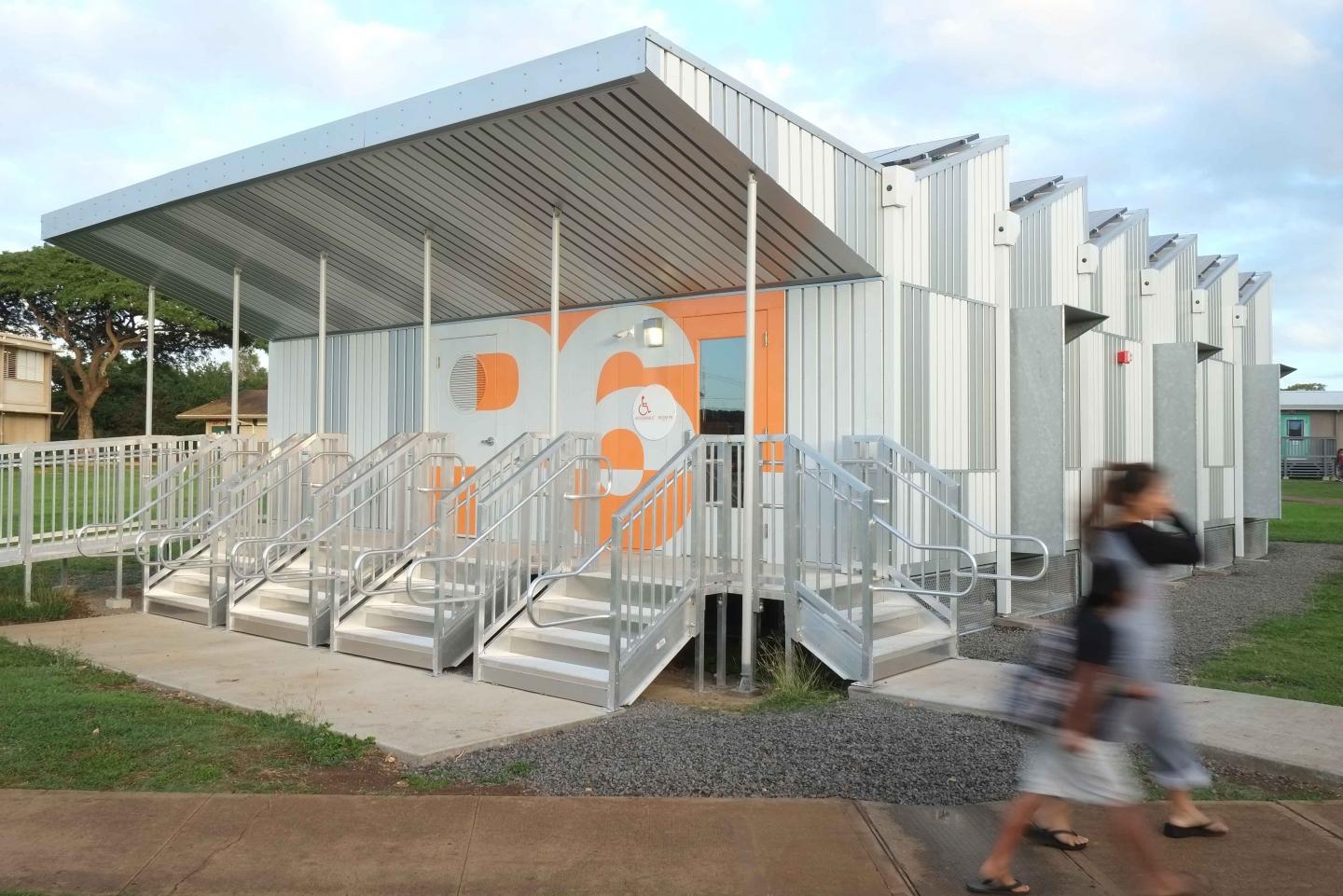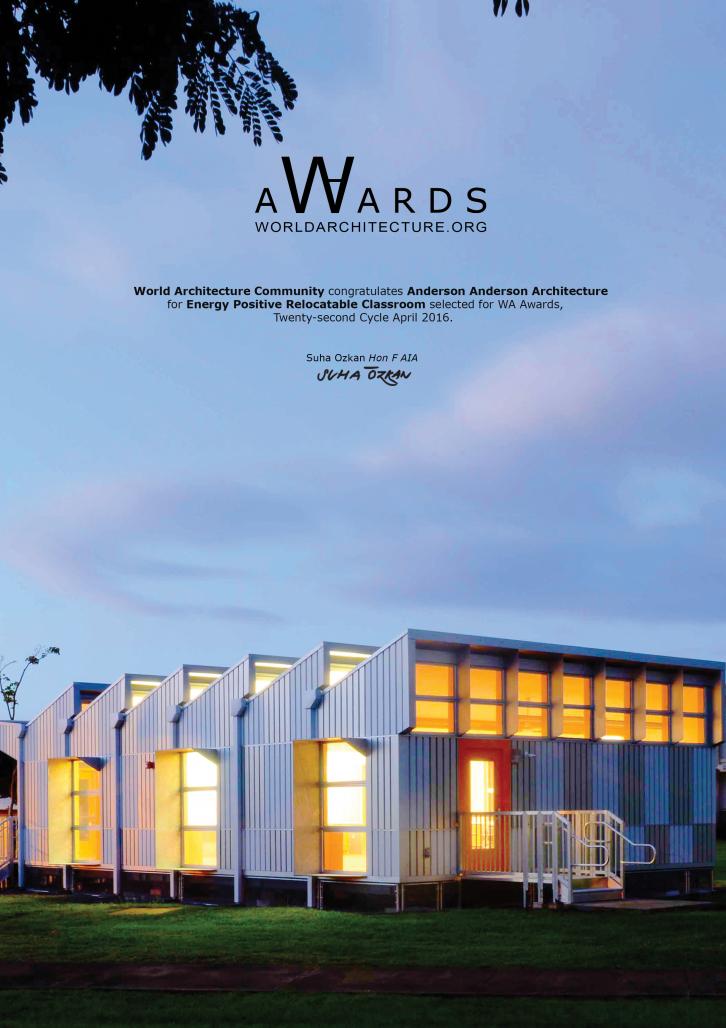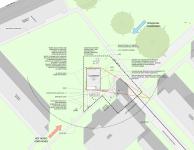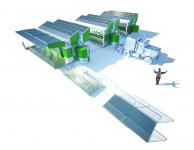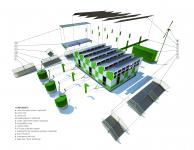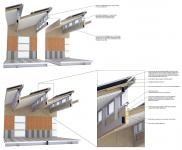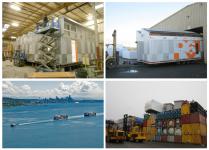This factory-built energy-positive relocatable classroom is a high-performance and healthy educational environment that uses a system of site-specific modular components to produce more power than it consumes. Building systems and natural forces are highlighted and monitored so that the prototype can serve as an educational tool and iterative model for sustainable classroom design.
This modular, off-site-fabricated classroom prototype was commissioned by the Hawaii Department of Education as a new model to replace the state’s current inventory of aging, poor quality and energy inefficient portables. Relocatable classrooms are a major presence in Hawaii’s sustainable future education planning. The project was competitively awarded to a design-build team based on highly detailed performance analysis modeling and thirty-year life cycle cost analyses. The building systems include extensive environmental monitoring systems broadcast to the web. A state-funded scientific team is evaluating the building performance through a two-year study. Based on scientific results and post-occupancy evaluation, the building will be revised as required for future units to be placed in numerous highly varied-climate ecosystems throughout the state. The easily relocatable building system is designed with flexibility and options for classroom comfort and energy efficiency in a wide range of climate conditions.
The relocatable classroom is designed to provide an optimized educational environment for students and teachers while advancing sustainable design principles in construction and in classroom learning. The classroom is designed to conserve as well as collect and generates natural resources, including electrical energy, daylight, wind energy, and rainwater. As well as being strong, efficient and conserving, natural forces and resources are highlighted and exposed throughout the structure, and all systems and performance criteria are monitored and broadcast to the web. The building acts as a learning tool for occupants, other schools, and the general public. The combination of maximized photovoltaic surface matched with low energy consumption creates a positive net energy production that is four times the building’s annual consumption.
The Energy Positive Portable Classroom optimizes photovoltaic roof surface orientation, naturally shaded north-facing daylight glazing, and modulated natural ventilation. All of these forces are balanced with the additional criteria of manufacturing and transport efficiency, functionality for classroom use, low operating costs and ease of maintenance. The manufacturing and delivery process, and the materials and products employed are all selected for minimum environmental impact and for maximum contribution to a healthy indoor environment. Wherever possible, materials are chosen to conserve resources, minimize initial and lifecycle maintenance costs, and to promote educational awareness of the natural environment and its relationship to comfortable and healthy living. The design focuses on performance issues directly impacting the learning experience of its occupants and the environmental quality of its community—thermal comfort, natural daylighting, indoor air quality, energy and resource conservation and generation.
The design provides excellent interior thermal, lighting and acoustic performance based on current research in optimized learning environments. The classroom is designed to minimize heat gain, and to use available natural daylight and natural ventilation rather than air-conditioning. Electrical systems are designed for contemporary and future digital teaching expectations, and for performance monitoring of energy consumption and interior environment charted against exterior weather conditions. Monitoring is web-broadcast and formatted as a child-accessible interface allowing students to interactively learn about their immediate environment and contextual sustainability issues. This web-broadcast data is integrated with curricula for various age groups and is publically accessible. As a comprehensive teaching tool, the building design exposes and highlights structural and performance components so that digital data is understood in reference to physical attributes of the construction. Materials, systems and surfaces are designed for healthy air quality and global sustainability. Construction is accomplished in an energy and resource-efficient factory, with a modular design facilitating future re-use on alternate sites, enhancing maximized sustainability throughout the life cycle.
The building is prefabricated in three easily transportable modules, reducing initial cost and energy, and facilitating efficient relocation and reuse in the future, minimizing waste. A steel frame and steel and rigid foam, sandwich panel floor and roof system minimize material use; maximize insulation and heat reflection; and deter pests and mold in the cavity-free structure. A simple, double wall metal cladding, along with metal roofing shaded by solar panels above a 3” ventilated airspace, creates a ventilated double skin greatly reducing heat gain. All glazing is operable and north facing and/or shaded to prevent direct sunlight, and to optimize natural ventilation and comfortable airflow. Interior surfaces are low VOC products. Exposed beams are FSC certified glue-laminated timbers combined with steel trusses to visibly trace primary structural forces. Interior surfaces are naturally finished, low VOC materials to provide good interior air quality. Daylighting analysis indicates that excellent work light levels are achieved throughout the typical school day in most locations without electric lighting. Thermal comfort analysis indicates the classroom will be comfortable in most high heat climates without air conditioning, although an efficient mechanical air conditioning system is also available as an option for school sites where air quality or noise conditions preclude natural ventilation.
The building was fully developed in BIM software and then modeled and analyzed in graphic and quantitative environmental analysis software. High performance goals in relation to ASHRAE 90.1-2007 were established and monitored by LEED AP personnel within the architecture and construction team and by building science consultants.
The team worked closely with university and industry-based building science-consulting teams in the design and performance analysis and monitoring. Modular, relocatable buildings of this size are not yet included in sustainability certification programs such as LEED and Coalition for High Performance Schools, but the CHP standards and minimum equivalents to LEED Platinum standards and evaluation practices were applied as baseline project specifications.
2011
2013
Energy Efficiency: PV Array Roof Surfaces; Directed Wind Scoops; Shading Devices; North Facing Clerestory Windows; Natural Ventilation; High-performance Insulation and Sealants; Coordinated Sensors and Electronic Control Lighting System; Rainwater Catchment (Optional).
Materials and Performance: Prefabricated Transportable Modules; Vented Double Skin; VOC Interior Surfaces; FSC Certified Glue-laminated Timber Beams with Steel Truss; Environmental Monitoring Systems Broadcast to the Web. (http://tinyurl.com/Powersmiths)
Indoor Comfort & Education Quality: Acoustical Optimization; Evenly distributed temperature and airflow; Optimized daylight distribution.
Life-Cycle Affordability: 30 year life-cycle budget analysis for state purchasing; Energy production and efficiency; Workplace quality and comfort increases quality of education, lowers cost; Modular design and construction minimizes consistent construction quality, improves labor life-quality, lowers cost.
Mark Anderson, Peter Anderson, Johnson Tang, Yevgeniy Ossipov, Gennifer Muñoz, Yingying Xue, Jia Wu, Chris Campbell, Brent Sumida, Matthias Steppuhn
Energy Positive Relocatable Classroom by Mark Anderson in United States won the WA Award Cycle 22. Please find below the WA Award poster for this project.
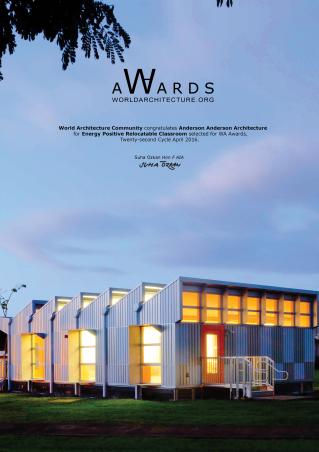
Downloaded 152 times.
Favorited 1 times
